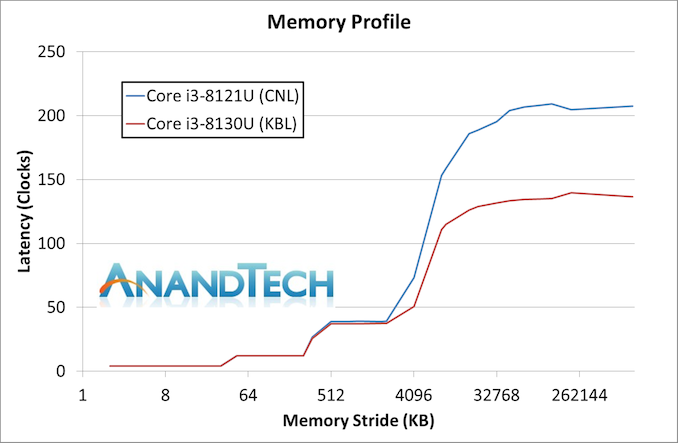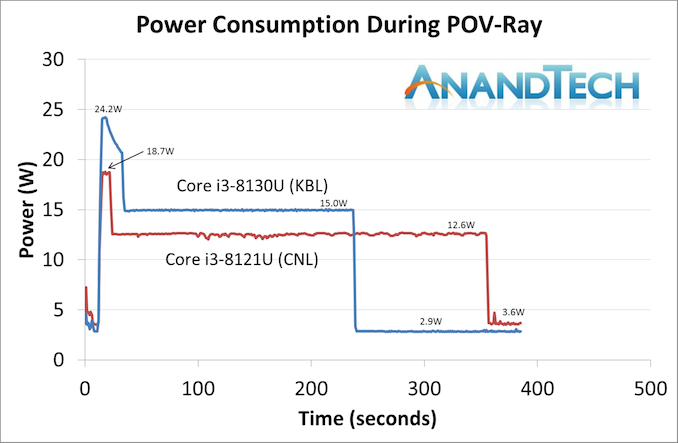Intel's 10nm Cannon Lake and Core i3-8121U Deep Dive Review
by Ian Cutress on January 25, 2019 10:30 AM ESTCPU Performance: Memory and Power
Memory
With the same memory setup as the standard Skylake-style core, without any other improvements, we should expect Cannon Lake to perform exactly similar. Here’s a recap of the memory configuration:
| Memory Comparison | ||
| Skylake Desktop | Cannon Lake | |
| L1-D Cache |
32 KiB/core 8-way |
32 KiB/core 8-way |
| L1-I Cache |
32 KiB/core 8-way |
32 KiB/core 8-way |
| L2 Cache |
256 KiB/core 4-way |
256 KiB/core 4-way |
| L3 Cache |
2 MiB/core 16-way |
2 MiB/core 16-way |
| L3 Cache Type | Inclusive | Inclusive |
For this test we put our Cannon Lake and Kaby Lake processors through our Memory Latency Checker test. Both systems had turbo modes disabled, forcing them to run at 2.2 GHz for parity and a direct microarchitecture comparison.
In this instance we see very little different between the two through the caches of the chip. Up to about 2MiB, both chips perform practically identical. Beyond this however, going out to main memory, there is a big discrepancy between the Kaby Lake and the Cannon Lake processor. In essence, accessing Cannon Lake main memory has an additional 50% latency.
At first we thought this was a bug. For both systems to have dual channel memory and running DDR4-2400, something had to be wrong. We double checked the setups – both systems were running in dual channel mode, giving the same memory bandwidth. The Cannon Lake processor was running at DDR4-2400 17-17-17, whereas the Kaby Lake system was at DDR4-2400 16-16-16 (due to memory SPD differences), which isn’t a big enough change to have such a big difference. The only reason we can come up with is that the memory controller on Cannon Lake must have additional overhead from the core to the memory controller – either a slower than expected PLL or something.
Power
Measuring the power of these thermally limited systems is somewhat frustrating in that we are at the whims of the quality of silicon at play. Bad silicon can get hotter faster, causing thermal throttling, or it depends on how the systems are set up for the peak power numbers. We use AIDA’s power monitoring tool to give us the power numbers for the CPUs during our POV-Ray test.
If you saw our How Intel Measures TDP article, you may be familiar with the concept of Power Limits. Intel processors have several power limits set in firmware – these values are set by the system manufacturer, and Intel provides ‘guidelines’. The two key values are Power Limit 1 (PL1), which describes a steady state scenario, and Power Limit 2 (PL2) which describes a turbo scenario. The reason why the system manufacturer gets control of these is because they might put a high wattage processor into a small form factor system, and need to manage performance – this is why we sometimes see a Core i7 be outperformed by a Core i5 in the same system design.
In most cases, PL1 is set to the TDP of the processor – in this case, it should be 15W. As shown on the graph above, this is true for our Core i3-8130U system, which shows a steady state power consumption of 15.0W. The Cannon Lake processor however only peaks at 12.6W.
PL2, the turbo power of the processor, can also be determined. For the Kaby Lake processor, we see a peak of 24.2 W, while the Cannon Lake has a turbo only of 18.7 W. We see that the turbo time period for the Cannon Lake processor is also much shorter, leading to a PL1 / steady state power much sooner.
Part of this is because we are pitting the Cannon Lake laptop against the Kaby Lake mini-PC. That being said, the Cannon Lake laptop is a beefy 15.6-inch unit, and has cooling for both the CPU and the discrete RX540 graphics, which isn’t doing much during this test except showing a basic 2D display.
That is arguably a lot more cooling than the mini-PC provides, plus we are cooling it with additional fans. These settings are more a function of both Lenovo doing what it wants to in firmware that we can’t change, but also the chip as engineered.
We can also calculate some level of efficiency here. By taking the area under the graph and correcting for the base line power (2.9 W on KBL, 3.6 W on CNL), we can calculate the total power consumed during the test. We get the following:
- Core i3-8121U (CNL) consumes 867 mWh
- Core i3-8130U (KBL) consumes 768 mWh
So this means that Cannon Lake is slower in AVX2 frequency, consumes more power, and scores 25% less in POV-Ray (see previous pages). That’s damning for the design.
To further look into this data, we disabled the turbo modes on both processors and ran our POV-Ray workload adjusting the number of threads being loaded and then measured the power consumption. In this scenario we are running at the same frequency, measuring the steady state power, and are thus at the whims of both the voltage set on both processors and the efficiency. Our tool also lets us measure the power of just the cores, so we’ll plot core power against threads loaded.
If this graph was the definitive graph, it shows that Cannon Lake is vastly inefficient (at 2.2 GHz) compared to Kaby Lake.














129 Comments
View All Comments
KOneJ - Sunday, January 27, 2019 - link
Bingo.Spunjji - Tuesday, January 29, 2019 - link
Truly magnificent.KateH - Saturday, January 26, 2019 - link
but please, if OP is interested in taking a whack at "articulating" i'd love to see what that looks like and how my translation faredMidwayman - Friday, January 25, 2019 - link
Interesing. So Basically no real possibility for desktop improvement until 2020 at least. They really are giving AMD a huge window to take the performance crown. Zen 2 is due to ship this year, right?BigMamaInHouse - Friday, January 25, 2019 - link
And dont forget- there are many Dual/Quad core (lets Say from Q6600 ~SandyBridge to 7700K ) Intel PC's that gonna be upgraded finally with new Ryzen launch and those PC won't we upgraded for another 3+ Years,DanNeely - Sunday, January 27, 2019 - link
The lower end of that range has been upgrading for years. The upper end has no real reason to upgrade unless they're doing something other than gaming, since current games don't benefit from the higher core counts much.I'm in the middle with a 4790K; and still see myself on track for a nominal 2022 upgrade; short of games growing CPU demands significantly or unexpected hardware failures I don't see any need to bring it forward. The additional cores will be nice for future proofing; but what I'm mostly looking forward to is all the stuff outside the CPU.
My notional want list is 10GB ethernet, PCIe4(5?) to the GPU and SSD, 50/50 USB 3.x A/C mix, and DDR5. The first of these is starting to show up on halo priced mobos.
PCIe4 is rumored to be launching this year on AMD, although from the leaks so far it's not clear if it'll only reach the first x16 slot for the GPU or be more widely available (maximum trace lengths are short enough that anything other than M.2 on a not-dimm will probably need signal boosters increasing costs).
Dual USB-C is starting to show up on a few boards; but widerspread availability is likely to be blocked until the hardware to handle flipping the connector moves from a separate chip into the chipset itself.
DDR5 is supposed to start shipping in very limited quantities this year, but will be another year or two before reaching consumer devices.
My guess is late 2020/early 2021 before all the hardware I want is finally available; which fits well with the nominal 8y lifespan I'm targeting for my systems core components.
shadowx360 - Friday, February 1, 2019 - link
What is the point of DDR5? It's going to be beyond overpriced at launch for negligible performance gain. As for USB-C, you can find cases with front connectors.Gondalf - Friday, January 25, 2019 - link
Ask to TSMC, we have not any real date of shipment. Moreover we don't know how the new SKUs will perform.eastcoast_pete - Saturday, January 26, 2019 - link
I don't think TSMC would give anybody except their customer (AMD) an expected shipping date. Also, while we don't know how the new AMD processors will perform, we already know that I Intel's 10 nm tech was both late and hasn't performed so we'll. BTW, I am currently running all PCs around me on Intel chips, so no fanboy here. This disappointing 10 nm fiasco is bad for all of us, as we need Intel to egg on AMD and vice versa. If one of them drops behind, the other one gets lazy.eastcoast_pete - Saturday, January 26, 2019 - link
Damn autocorrect and no edit!